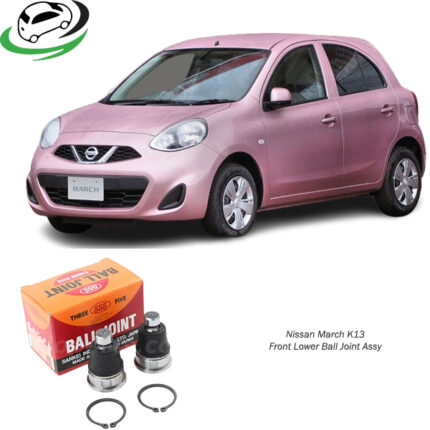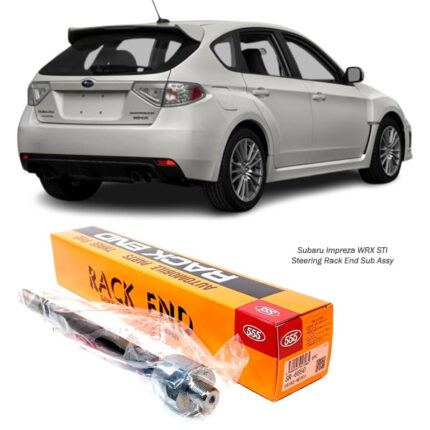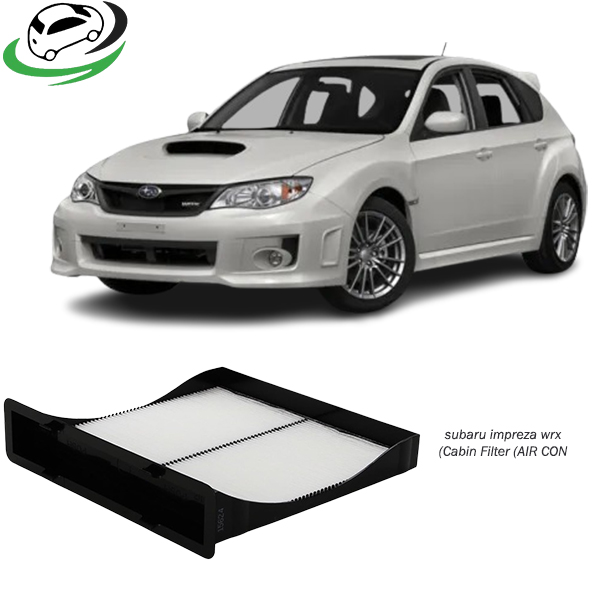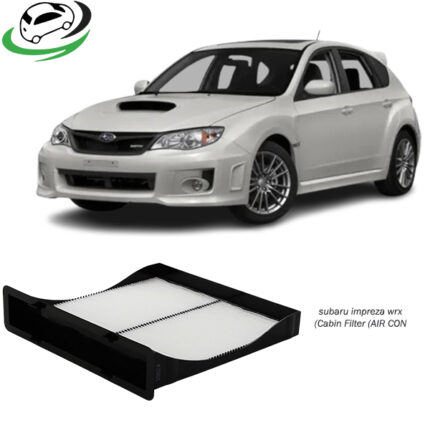Get Subaru Impreza WRX Cabin Filter (Air Con) 72880-FG000 in Kenya
The cabin filter—often called the air conditioning (A/C) filter or air cabin filter—is a vital component of a vehicle’s HVAC (heating, ventilation, and air conditioning) system. Although relatively small and sometimes overlooked in vehicle maintenance, the cabin filter plays a crucial role in ensuring the air quality within the vehicle’s interior by filtering out contaminants like dust, pollen, and harmful particles. This improves the comfort and health of passengers and also enhances the vehicle’s overall HVAC performance.
1. Purpose of the Cabin Filter
The primary function of the cabin filter is to clean the air that enters the vehicle’s cabin through the HVAC system. By capturing dust, pollen, exhaust gases, and other airborne particles, the cabin filter helps improve indoor air quality and prevent these contaminants from affecting passengers. The filter also helps eliminate bad odors and reduces allergens, making it especially important for individuals with respiratory issues or allergies.
Additionally, a cabin filter contributes to the efficiency of the HVAC system itself. By trapping debris before it enters the HVAC system, the filter prevents particles from clogging the A/C evaporator and heater core, thus avoiding costly repairs and improving airflow.
2. Types of Cabin Filters
There are three main types of cabin filters, each offering different filtration capabilities based on materials and design:
a) Particle Cabin Filters
- Construction: Made from dense, high-quality paper or synthetic materials, particle cabin filters are designed to trap larger particles such as dust, pollen, and mold spores.
- Application: These filters are widely used as standard filters in many vehicles, providing basic filtration sufficient for most environments.
- Limitations: Particle filters do not filter out gases, smoke, or odors, making them less effective in polluted or urban areas.
b) Activated Carbon Cabin Filters
- Construction: Activated carbon filters contain layers of activated charcoal in addition to the particle filter material. The carbon layer has porous properties, allowing it to absorb harmful gases and odors.
- Application: Activated carbon filters are ideal for urban driving or environments with higher pollution levels, as they filter out unpleasant smells and harmful gases such as ozone, sulfur dioxide, and nitrogen oxides.
- Limitations: These filters are slightly more expensive than standard particle filters but offer a higher level of protection for urban or high-pollution environments.
c) HEPA Cabin Filters
- Construction: High-Efficiency Particulate Air (HEPA) filters are made from specialized materials that can capture microscopic particles as small as 0.3 microns, including bacteria and some viruses.
- Application: HEPA filters provide the highest level of filtration, making them suitable for individuals with severe allergies or those frequently driving in dusty or polluted environments.
- Limitations: HEPA filters are the most expensive type, and their dense construction can restrict airflow in some vehicles, slightly impacting HVAC performance.
3. Structure and Components of a Cabin Filter
A cabin filter typically comprises multiple layers:
- Primary Filter Layer: The outer layer catches large debris such as leaves and dust particles.
- Microfiber Layer: This inner layer traps smaller particles like pollen and fine dust.
- Activated Carbon Layer (for carbon filters): The carbon layer neutralizes odors and captures certain gases.
- Support Structure: Most cabin filters have a plastic or metal frame that provides stability and fits securely into the filter housing.
Each layer serves a specific purpose, enhancing the filter’s ability to capture a wide range of contaminants and ensuring efficient filtration without impacting airflow.
4. Benefits of a Cabin Filter
The cabin filter offers several key benefits that contribute to both comfort and vehicle performance:
- Improved Air Quality: By trapping airborne pollutants, the filter ensures that passengers breathe cleaner air, reducing exposure to pollutants and allergens.
- Odor Reduction: Activated carbon filters effectively remove unpleasant odors, making for a more enjoyable driving experience.
- HVAC System Protection: A clean cabin filter prevents dust and debris from entering the HVAC system, protecting components such as the blower motor and evaporator and extending their lifespan.
- Enhanced HVAC Efficiency: With reduced blockage from particles, the HVAC system can maintain optimal airflow and cooling/heating performance, resulting in better fuel efficiency.
5. Signs of a Worn or Dirty Cabin Filter
Over time, the cabin filter accumulates dirt and debris, which can compromise its effectiveness and negatively impact the HVAC system. Common signs that indicate it’s time to replace the cabin filter include:
- Reduced Airflow: A clogged filter restricts airflow, causing weak ventilation even when the fan is set to high.
- Unpleasant Odors: If the filter is saturated with debris, it can start to emit musty or unpleasant smells, particularly when the A/C or heater is on.
- Increased Dust in Cabin: A dirty filter loses its effectiveness, allowing more dust to circulate in the cabin.
- Fogged Windows: Limited airflow can reduce defogging capability, making it harder to keep windows clear.
- Higher HVAC Noise: When the filter is clogged, the blower motor has to work harder to maintain airflow, causing increased noise.
6. Cabin Filter Maintenance and Replacement
Maintaining the cabin filter is crucial to ensure clean air and optimal HVAC performance. Here are some tips for effective cabin filter maintenance:
a) Replacement Frequency
Most manufacturers recommend replacing the cabin filter every 12,000 to 15,000 miles or at least once a year. However, driving conditions can affect this interval:
- Urban and Polluted Areas: Vehicles driven in cities with high pollution levels may require more frequent filter changes.
- Rural or Dusty Areas: Drivers in rural or off-road conditions, where dust is prevalent, may also need to replace the cabin filter more often.
- Allergy Considerations: Those with respiratory issues or allergies should consider changing the filter more frequently for optimal air quality.
b) How to Replace a Cabin Filter
Replacing the cabin filter is usually straightforward and can be done at home in most vehicles:
- Locate the Filter Compartment: The cabin filter is generally behind the glove compartment or under the dashboard.
- Access the Filter Housing: Remove any screws or clips to access the filter housing. Some glove compartments need to be emptied or lowered to access the filter.
- Remove the Old Filter: Slide the old filter out, noting its orientation to ensure the new one is installed correctly.
- Install the New Filter: Insert the new filter, making sure it’s properly aligned.
- Reassemble the Compartment: Secure the filter housing and return any components to their original position.
7. Cabin Filter and Vehicle Performance
A well-maintained cabin filter directly contributes to the efficiency of the HVAC system. Clean airflow allows the air conditioning and heating systems to work more effectively, which reduces the load on the vehicle’s engine. This can contribute to improved fuel economy and a prolonged HVAC lifespan.
Moreover, a clean filter prevents particles from building up on the evaporator coil, reducing the likelihood of mold growth and potential odors in the system.
8. Cost of Cabin Filters
Cabin filter prices can vary based on type and brand:
- Standard Particle Filters: Usually range from $10 to $30, depending on the vehicle model.
- Activated Carbon Filters: Cost between $20 and $50, providing more filtration for urban or polluted areas.
- HEPA Filters: Typically priced between $40 and $80, offering top-tier filtration for allergy sufferers or those needing high air quality.
Installation costs depend on labor rates but are generally low, as cabin filters are easy to replace.
9. Environmental Considerations
Changing a cabin filter not only benefits air quality but also has environmental impacts:
- Reduced Emissions: Cleaner airflow reduces the workload on the HVAC system, indirectly lowering engine emissions by decreasing fuel consumption.
- Proper Disposal: Used filters should be disposed of properly, as they can contain collected pollutants and allergens.
10. Conclusion
The cabin filter is essential to vehicle comfort, HVAC efficiency, and passenger health. Though often overlooked, it plays a significant role in maintaining clean air, filtering out dust, pollen, and other pollutants, and contributing to the HVAC system’s longevity. Regular maintenance and timely replacement of the cabin filter ensure that a vehicle’s interior air quality remains high, keeping passengers safe and comfortable.
Follow us on Facebook for more parts.




